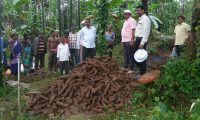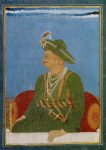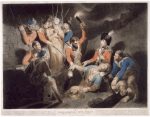 A cache of more than 1,000 18th century artillery “rockets” has been found in the village of Bidanuru in the Shimoga district of Karnataka, southwestern India. Workers found the early shells while digging out an abandoned dry well. The iron cylinders used by the King of Mysore, Tipu Sultan, to fight against the British forces that would, after his death, conquer the subcontinent, were recognized by the diggers as the king’s rockets and archaeologists were called in to the excavate them.
A cache of more than 1,000 18th century artillery “rockets” has been found in the village of Bidanuru in the Shimoga district of Karnataka, southwestern India. Workers found the early shells while digging out an abandoned dry well. The iron cylinders used by the King of Mysore, Tipu Sultan, to fight against the British forces that would, after his death, conquer the subcontinent, were recognized by the diggers as the king’s rockets and archaeologists were called in to the excavate them.
“Excavation of the open well led to unearthing of over 1,000 corroded rockets that were stored during Tipu’s times for use in wars,” R Shejeshwara Nayaka told Agence France-Presse from the site, 240 miles north-west of the state capital, Bangalore.
“Digging of the dry well where its mud was smelling like gunpowder led to the discovery of the rockets and shells in a pile.”
It took three days for the 15-member team of archaeologists, excavators and labourers to unearth the armoury and ammunition.
 Tipu Sultan came to throne already in a state of war against the British. His father Haider Ali had fought them off an on (mainly on) since 1767, and after his death from cancer on December 7th, 1782, Tipu Sultan picked up where Haider Ali had left off fighting the Second Anglo-Mysore War. His success on the battlefield forced the British to sue for peace in 1784, the last time they would come to the treaty table as supplicants in India.
Tipu Sultan came to throne already in a state of war against the British. His father Haider Ali had fought them off an on (mainly on) since 1767, and after his death from cancer on December 7th, 1782, Tipu Sultan picked up where Haider Ali had left off fighting the Second Anglo-Mysore War. His success on the battlefield forced the British to sue for peace in 1784, the last time they would come to the treaty table as supplicants in India.
Tipu was known as a strong warrior from an early age. His father, keenly conscious of his own illiteracy, had ensured his son had the very best education, particularly in military matters, available. French officers in the employ of Haider Ali tutored his son in arms and combat and they were apparently damn good at it. Tipu first accompanied his father on campaign, the invasion of Malabar, when he was 15. By the time he was 16, he was commanding cavalry corps and competently, no less.
Haider Ali began using iron rockets in the 1780s — he had more than a thousand men in his rocket corps — but it was in the Third Anglo-Mysore War (1790–1792) that Tipu Sultan turned it up to eleven, increasing his rocket men to 5,000, developing the iron-encased artillery shell to peak power and precision and pioneering its use in mass rocket attacks against the British East India Company and its Indian allies.
 Measuring around 10 inches long, the enclosed iron tubes were filled with gunpowder and tied to the end of a bamboo shaft. That made them portable and compact enough to be launched by an individual soldier. The black powder combusted inside the iron chamber and acted as a propellant to give the shells lift and reach. Some would burst in the air at the target; others would bounce on the ground until the charge was spent.
Measuring around 10 inches long, the enclosed iron tubes were filled with gunpowder and tied to the end of a bamboo shaft. That made them portable and compact enough to be launched by an individual soldier. The black powder combusted inside the iron chamber and acted as a propellant to give the shells lift and reach. Some would burst in the air at the target; others would bounce on the ground until the charge was spent.
Mysorean rockets were significantly more accurate and nimble than European artillery. Their range was over a mile and they could be aimed with great precision. European rockets weren’t made of iron and so were not strong enough to stay intact and contain the combustion of the powder so they had a more limited reach. They were the first iron-encased rockets to be successfully deployed in combat and indeed were so successful that the British took note, using them as the prototype for their own foray into the iron rocket business, the Congreve rockets developed by Sir William Congreve in 1804 and immediately put to use in the Napoleonic wars.
 Some of Tipu Sultain’s rockets have been unearthed before near the current find site, but never in so great a number. Tipu, whose father had conquered Karnataka in 1763 and absorbed it into the Kingdom of Mysore, appears to have used the spot as a hidden weapons depot to use against British forces in a pinch. It was not enough to save his kingdom or his life. Tipu Sultan died on May 4th, 1799, while valiantly defending his fort of Srirangapatna during the Fourth Anglo-Mysore War. The British victory was decisive, ending the Kingdom of Mysore, installing puppet princes from the feudal dynasty Haider Ali had ousted who reigned in name only until India became an independent republic in 1947.
Some of Tipu Sultain’s rockets have been unearthed before near the current find site, but never in so great a number. Tipu, whose father had conquered Karnataka in 1763 and absorbed it into the Kingdom of Mysore, appears to have used the spot as a hidden weapons depot to use against British forces in a pinch. It was not enough to save his kingdom or his life. Tipu Sultan died on May 4th, 1799, while valiantly defending his fort of Srirangapatna during the Fourth Anglo-Mysore War. The British victory was decisive, ending the Kingdom of Mysore, installing puppet princes from the feudal dynasty Haider Ali had ousted who reigned in name only until India became an independent republic in 1947.
The cache will be conserved and displayed in a “rocket gallery” in the Shivappa Nayaka Palace Museum in Shivamogga city, a palace built, as it happens, by Haider Ali, even though it bears the name of the Nayaka dynasty he overthrew.
“Fireworks” were known to Indian warfare much earlier 🙁
A certain Johann (Hans) Schiltberger (1380 – c. 1440) was a German POW and writer. At the Battle of Nicopolis, in 1396AD, he was wounded and taken prisoner.
On Bayezid’s overthrow at the Battle of Ankara (in 1402), Schiltberger passed into the service of Bayezid’s conqueror Timur (“Tamerlane”), who in 1398 invaded northern India [apparently with Schiltberger], attacking the Delhi Sultanate ruled by Sultan Nasir-ud-Din Mahmud Shah Tughluq of the Tughlaq Dynasty.
Schildberger’s work was first edited at Augsburg, about 1460; four other editions appeared in the 15th century, and six in the 16th.
As far as India is concerned, Schiltberger exaggerates:
————————–
“When Timur returned from Babylon, he gave orders to prepare within four months, as he planned to progress into ‘Little[?]’ India [“clain India”], which lies four months away from his capital. And as this time had passed, he moved against ‘Little India’ with thirteen hundred thousand men, passed a desert within twenty days, and there is a great shortage of water, and after that, there were mountains that took 8 days to pass. There was a spot in those mountains, where the camels and horses had to be bound onto boards, and this way they had to be taken downwards. After that there was a very dark valley for half a day, and one hardly could see each other. Then, there were forested mountains for three days and three nights, until he came onto a large plain leading further to the capital [Delhi], and on that plain he had to fight. He then messaged to their king [..] and demanded a surrender, but the king moved in against Timur with four hundred thousand men and 400 elephants that had been prepared for combat, and atop of each of those elephants there were wooden towers with a least 10 warriors. [..] And as Timur realized the elephants, he gave orders to lighten up wood that had been mounted onto his camels, and that the shrieking camels were to be driven against the elephants under the shouts of his men, which resulted in shouts of the elephant warriors and the elephants went wild, trying to escape. Then Timur attacked with full force the king and the elephants, and many elephants were killed. The king escaped into his city, which was laid under siege for ten days, until an arrangement was made that two ‘zenten’ of Indian gold had to be paid, and their gold is purer than the Arab one, and the king also handed out a lot of precious stones and promised to provide 30 thousand men, and the king could keep his realm and Timur returned home with hundred elephants and the goods that the king had provided.”
Referring to that rather odd distinction between the “little” and the “greater” India [“die grosse India” and “die claine India”], he annotates e.g. -referring to the features of ‘Persia’: “..Also, a city with the name Hormus, and it is a large city by the sea, from where one sails to the greater India, while regularly traders from India sail to that point, which has good soil.”
Contrastingly, as far as the “little” India is concerned: “..and likewise, I’ve been to little India, which is a beautiful kingdom and its capital is Delhi [Dili]. And in that country there are many elephants, and also an animal that is referred to as ‘suruafa’ [seemingly, a giraffe], similar to a deer, and it is quite tall and has an elongated neck, which is four ‘claffter’ long or more, and it has high legs in front and shorter rear ones, and there are quite many animals in little India, many parakeets [vil sitichen] and ostriches [peacocks, maybe?] live there, and there are many other birds and animals that i am not able to even give names for.”
More obvious are his remarks about the “greater” India, that he said he did not visit. Apparently, he is referring to Indonesia (which -in contrast to himself- I have visited – Har har):
————
“In the greater India i have not been, where they grow the pepper, but i heard a lot about it from the pagan [sea]farers, who saw it and where the pepper is grown and how. I heard it grows near a place that they call ‘Lambe'[?], and there it grows in a forest that is at least fourteen days wide, and in that forest, they say, are two cities and many villages, and they all were Christian, and there it is really a lot of heat, where the pepper is grown. It grows on trees, described similar to trellis vines; and those trees bear a lot of it, and the pepper is similar to blackthorn, and when it is ripe it is green, when it is taken down with all the berries it is dried in the sun until it gets thin and dry [i.e. more or less the procedure that i have witnessed, but when dry, it gets black]. Three types of peppers are grown, the long one, the white and the black one, which grows with the leafs, then grows the white one, which is the best and is kept for themselves, and there is not as much of it. Due to the heat, they say, there are a lot of snakes, and many say, when the pepper is about to be harvested, they make a fire in the forest and get rid of the snakes, therefore the pepper was black and that was not [?] when they make a fire therein, as the trees would get thin and would not bear pepper any more. Be informed that they wash their hands with apples that they refer to as ‘limon’ or with other ‘kraut’ that they have, so the snakes are kept away with the smoke and they pick the pepper. In those countries mentioned, they also grow a lot of ginger and a lot of other good ‘spetzerey’ and spices.”
Very interesting and informative article!! Including comments!
…just found out there is already an existing translation :shifty: ..freely available under:
http://www.gutenberg.org/ebooks/52569
:hattip:
Tipu Sultan is known for his heroic efforts to combat colonialism. Tipu, the Indian pioneer of freedom and independence had to keep an eye on the Portuguese presence in Goa, the French stablishment in Mahe who received their logistical requirements from Pondicherry, Karaikal and Yanam. The Dutch East India Company presence was all over the South and South East India and the British in the rest of India. Historians marvel at the ability, organizational skills and his preparedness to repel the constant raids of the western rivals for supremacy and trade monopoly in the region.